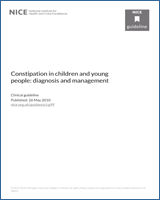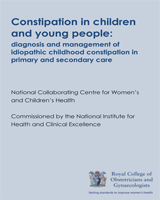Assessment and diagnosis
History-taking and physical examination
Establish during history-taking whether the child or young person has constipation. Two or more findings from indicate constipation.
If the child or young person has constipation take a history using to establish a positive diagnosis of idiopathic constipation by excluding underlying causes. If a child or young person has any ‘red flag’ symptoms do not treat for constipation. Instead, refer them urgently to a healthcare professional with experience in the specific aspect of child health that is causing concern.
Do a physical examination. Use to establish positive diagnosis of idiopathic constipation by excluding underlying causes. If a child or young person has any ‘red flag’ symptoms do not treat them for constipation. Instead refer them urgently to a healthcare professional with experience in the specific aspect of child health that is causing concern.
If the history-taking and/or physical examination show evidence of faltering growth treat for constipation and test for coeliac disease** and hypothyroidism.
If either the history-taking or the physical examination show evidence of possible maltreatment treat for constipation and refer to ‘When to suspect child maltreatment’, NICE clinical guideline 89 (2009).
If the physical examination shows evidence of perianal streptococcal infection, treat for constipation and also treat the infection.
Inform the child or young person and his or her parents or carers of a positive diagnosis of idiopathic constipation and also that underlying causes have been excluded by the history and/or physical examination. Reassure them that there is a suitable treatment for idiopathic constipation but that it may take several months for the condition to be resolved.
Digital rectal examination
A digital rectal examination should be undertaken only by healthcare professionals competent to interpret features of anatomical abnormalities or Hirschsprung's disease.
If a child younger than 1 year has a diagnosis of idiopathic constipation that does not respond to optimum treatment within 4 weeks, refer them urgently to a healthcare professional competent to perform a digital rectal examination and interpret features of anatomical abnormalities or Hirschsprung's disease.
Do not perform a digital rectal examination in children or young people older than 1 year with a ‘red flag’ (see and ) in the history-taking and/or physical examination that might indicate an underlying disorder. Instead, refer them urgently to a healthcare professional competent to perform a digital rectal examination and interpret features of anatomical abnormalities or Hirschsprung's disease.
For a digital rectal examination ensure:
privacy
informed consent is given by the child or young person, or the parent or legal guardian if the child is not able to give it, and is documented
a chaperone is present
the child or young person's individual preferences about degree of body exposure and gender of the examiner are taken into account
all findings are documented.
Clinical investigations
Endoscopy
Do not use gastrointestinal endoscopy to investigate idiopathic constipation.
Coeliac disease and hypothyroidism
Test for coeliac disease** and hypothyroidism in the ongoing management of intractable constipation in children and young people if requested by specialist services.
Manometry
Do not use anorectal manometry to exclude Hirschsprung's disease in children and young people with chronic constipation.
Radiography
Do not use a plain abdominal radiograph to make a diagnosis of idiopathic constipation
Consider using a plain abdominal radiograph only if requested by specialist services in the ongoing management of intractable idiopathic constipation.
Rectal biopsy
Do not perform rectal biopsy unless any of the following clinical features of Hirschsprung's disease are or have been present:
delayed passage of meconium (more than 48 hours after birth in term babies)
constipation since first few weeks of life
chronic abdominal distension plus vomiting
family history of Hirschsprung's disease
faltering growth in addition to any of the previous features.
Transit studies
Do not use transit studies to make a diagnosis of idiopathic constipation.
Consider using transit studies in the ongoing management of intractable idiopathic constipation only if requested by specialist services.
Ultrasound
Do not use abdominal ultrasound to make a diagnosis of idiopathic constipation.
Consider using abdominal ultrasound in the ongoing management of intractable idiopathic constipation only if requested by specialist services.
Clinical management
Disimpaction
Assess all children and young people with idiopathic constipation for faecal impaction, including children and young people who were originally referred to the relevant services because of ‘red flags’ but in whom there were no significant findings following further investigations (see and ). Use a combination of history-taking and physical examination to diagnose faecal impaction – looking for overflow soiling and/or faecal mass palpable abdominally and/or rectally if indicated.
Start maintenance therapy if the child or young person is not faecally impacted.
Offer the following oral medication regimen for disimpaction if indicated:
Polyethylene glycol 3350 + electrolytes, using an escalating dose regimen (see ) as the first-line treatment
*. Polyethylene glycol 3350 + electrolytes may be mixed with a cold drink.
Add a stimulant laxative using if polyethylene glycol 3350 + electrolytes does not lead to disimpaction after 2 weeks.
Substitute a stimulant laxative singly or in combination with an osmotic laxative such as lactulose (see ) if polyethylene glycol 3350 + electrolytes is not tolerated.
Inform families that disimpaction treatment can initially increase symptoms of soiling and abdominal pain initially
Do not use rectal medications for disimpaction unless all oral medications have failed and only if the child or young person and their family consent.
Administer sodium citrate enemas only if all oral medications for disimpaction have failed.
Do not administer phosphate enemas for disimpaction unless under specialist supervision in hospital/healthcare centre/clinic, and only if all oral medications and sodium citrate enemas have failed.
Do not perform manual evacuation of the bowel under anaesthesia unless optimal treatment with oral and rectal medications has failed.
Review children and young people undergoing disimpaction within 1 week.
Maintenance therapy
Start maintenance therapy as soon as the child or young person's bowel is disimpacted.
Reassess children frequently during maintenance treatment to ensure they do not become reimpacted and assess issues in maintaining treatment such as taking medicine and toileting. Tailor the frequency of assessment to the individual needs of the child and their families (this could range from daily contact to contact every few weeks). Where possible, reassessment should be provided by the same person/team.
Offer the following regimen for ongoing treatment or maintenance therapy:
Polyethylene glycol 3350 + electrolytes as the first-line treatment.
*Adjust the dose of polyethylene glycol 3350 + electrolytes according to symptoms and response. As a guide for children and young people who have had disimpaction the starting maintenance dose might be half the disimpaction dose (see ).
Add a stimulant laxative (see ) if polyethylene glycol 3350 + electrolytes does not work.
Substitute a stimulant laxative if polyethylene glycol 3350 + electrolytes is not tolerated by the child or young person. Add another laxative such as lactulose or docusate (see ) if stools are hard.
Continue medication at maintenance dose for several weeks after regular bowel habit is established – this may take several months. Children who are toilet training should remain on laxatives until toilet training is well established. Do not stop medication abruptly: gradually reduce the dose over a period of months in response to stool consistency and frequency. Some children and young people may require laxative therapy for several years. A minority may require ongoing laxative therapy.
Diet and lifestyle
Do not use dietary interventions alone as first-line treatment for idiopathic constipation.
Treat constipation with laxatives and a combination of:
Negotiated and non-punitive behavioural interventions suited to the child or young person's stage of development. These could include scheduled toileting and support to establish a regular bowel habit, maintenance and discussion of a bowel diary, information on constipation, and use of encouragement and rewards systems
Dietary modifications to ensure a balanced diet and sufficient fluids are consumed (see recommendation below).
Advise parents and children (where appropriate) that a balanced diet should include:
Adequate fluid intake (see )
Adequate fibre. Recommend including foods with a high fibre content (such as fruit, vegetables, high-fibre bread, baked beans and wholegrain breakfast cereals) (not applicable to exclusively breastfed infants). Do not recommend unprocessed bran, which can cause bloating and flatulence and reduce the absorption of micronutrients.
American dietary recommendations: IoM (2005) IoM (Institute of Medicine) (2005). Dietary reference intakes for water, potassium, sodium chloride and sulfate. Washington DC: The National Academies Press.
Provide children and young people with idiopathic constipation and their families with written information about diet and fluid intake.
In children and young people with idiopathic constipation, start a cows' milk exclusion diet only on the advice of the relevant specialist services.
Advise daily physical activity that is tailored to the child or young person's stage of development and individual ability as part of ongoing maintenance in children and young people with idiopathic constipation.
Psychological interventions
Do not use biofeedback for ongoing treatment in children and young people with idiopathic constipation.
Do not routinely refer children and young people with idiopathic constipation to a psychologist or child and adolescent mental health services unless the child or young person has been identified as likely to benefit from receiving a psychological intervention.
Antegrade colonic enema procedure
Refer children and young people with idiopathic constipation who still have unresolved symptoms on optimum management to a paediatric surgical centre to assess their suitability for an antegrade colonic enema (ACE) procedure.
Ensure that all children and young people who are referred for an ACE procedure have access to support, information and follow-up from paediatric healthcare professionals with experience in managing children and young people who have had an ACE procedure.
Information and support
Provide tailored follow-up to children and young people and their parents or carers according to the child or young person's response to treatment, measured by frequency, amount and consistency of stools (use the Bristol Stool Form Scale to assess this, see appendix G). This could include:
telephoning or face-to-face talks
giving detailed evidence-based information about their condition and its management, this might include, for example, the ‘Understanding NICE guidance’ leaflet for this guideline
giving verbal information supported by (but not replaced by) written or website information in several formats about how the bowels work, symptoms that might indicate a serious underlying problem, how to take their medication, what to expect when taking laxatives, how to poo, origins of constipation, criteria to recognise risk situations for relapse (such as worsening of any symptoms, soiling etc.) and the importance of continuing treatment until advised otherwise by the healthcare professional.
Offer children and young people with idiopathic constipation and their families a point of contact with specialist healthcare professionals, including school nurses, who can give ongoing support.
Healthcare professionals should liaise with school nurses to provide information and support, and to help school nurses raise awareness of the issues surrounding constipation with children and young people and school staff.
Refer children and young people with idiopathic constipation who do not respond to initial treatment within 3 months to a practitioner with expertise in the problem.



